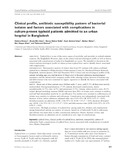Clinical profile, antibiotic susceptibility pattern of bacterial isolates and factors associated with complications in culture‐proven typhoid patients admitted to an urban hospital in Bangladesh
Date
2018-02-12Publisher
Wiley Online LibraryAuthor
Khatun, HalimaIslam, Shoeb Bin
Naila, Nurun Nahar
Islam, Syed Aminul
Nahar, Baitun
Alam, Nur Haque
Ahmed, Tahmeed
Metadata
Show full item recordCitation
Khatun, H., Islam, S. B., Naila, N. N., Islam, S. A., Nahar, B., Alam, N. H., & Ahmed, T. (2018). Clinical profile, antibiotic susceptibility pattern of bacterial isolates and factors associated with complications in culture-proven typhoid patients admitted to an urban hospital in Bangladesh. Tropical Medicine and International Health, 23(4), 359-366. doi:10.1111/tmi.13037Abstract
Typhoid fever is one of the major causes of morbidity and mortality in typhoid endemic countries like Bangladesh. However, data on the clinical and microbiological profile as well as factors associated with complications of typhoid in Bangladesh are scarce. We intended to characterise the clinical and microbiological profile of culture-proven typhoid fever and to identify factors associated with complications. Methodology: Retrospective analysis of clinical data from 431 patients with culture-confirmed typhoid fever admitted to Dhaka hospital of International Centre for Diarrhoeal Disease Research, Bangladesh, between January 2010 and December 2014. Clinical and microbiological profiles of the patients including age, sex, and duration of illness prior to hospital admission, haematological parameters and the antimicrobial resistance profile of the infecting isolate, duration of hospital stay and defervescence time were examined by logistic regression to identify the factors associated with complications. Result: About one of three patients were children under 5 years, and 21.5% of them were severely malnourished. During hospitalisation, 17.4% patients developed complications; mainly encephalopathy (6.7%), ileus (6.5%) and pneumonia (3.5%). Among culture-positive cases, 28.3% isolates showed multidrug resistant (MDR) and more than 90% of isolates were resistant to nalidixic acid and had intermediate sensitivity to ciprofloxacin. Five isolates were resistant to azithromycin; all isolates were sensitive to cefixime and ceftriaxone. Complication was independently associated with duration of fever before admission (adjusted odds ratio: 0.85; 95% CI: 0.074–0.97; P < 0.05), thrombocytopenia on admission (AOR: 2.84; 95% CI: 01.06–7.57; P < 0.05), duration of hospital stay (AOR: 1.34; 95% CI: 1.15–1.57; P < 0.01) and defervescence time (AOR: 0.83; 95% CI: 0.70–0.99; P < 0.05). Conclusion: The high prevalence of typhoid fever among under-five children and complications among hospitalised patients are matters of concern. Sensitivity of Salmonella Typhi to ceftriaxone and cefixime was better than to other conventional antibiotics. Shorter duration of fever and thrombocytopenia on admission can be considered as early signs of complications. © 2018 John Wiley & Sons Ltd

